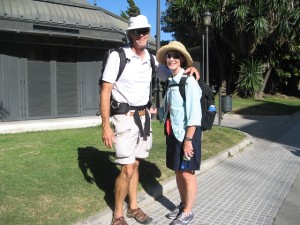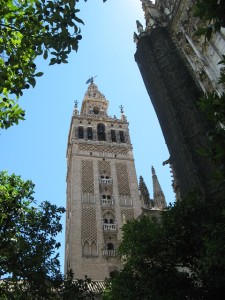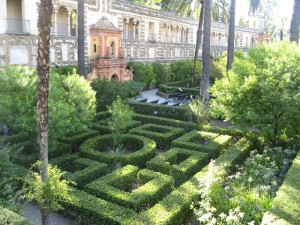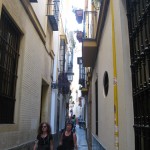July 20 – 22, 2014 –
 Strapping on our backpacks we took the 2-hour train to Seville for two nights. What a fabulous city!! It is filled with history, tiles, young people, tapas bars, and oranges. Yes, oranges. There are orange trees everywhere! And right now they are laden with green fruit that looks like limes. In another month or so there should be oranges for sale on every corner in Spain. Every main street and many side streets are lined with orange trees; they are also in parks and private gardens. The oranges here are wonderful – very sweet and juicy with few seeds. We are looking forward to the harvest! They really out do the California and Florida oranges that we are used to.
Strapping on our backpacks we took the 2-hour train to Seville for two nights. What a fabulous city!! It is filled with history, tiles, young people, tapas bars, and oranges. Yes, oranges. There are orange trees everywhere! And right now they are laden with green fruit that looks like limes. In another month or so there should be oranges for sale on every corner in Spain. Every main street and many side streets are lined with orange trees; they are also in parks and private gardens. The oranges here are wonderful – very sweet and juicy with few seeds. We are looking forward to the harvest! They really out do the California and Florida oranges that we are used to.
Another hop on/hop off bus tour gave us a lay of the land for the city. The maps provided by the tourist office were confusing with print that was much too small. That gave us an opportunity to get in a lot more walking while finding places.
 The Cathedral at Seville is the third largest cathedral in the world behind the Vatican and St. Paul’s in London and has the largest Gothic chapel in the world. Originally built as a mosque, most of it was torn down in 1401 after the Christians took Seville from the Moors in 1248. The “new” cathedral was finished in 1507. Remaining from the original structure is the minaret (tall, slender tower, typically part of a mosque, where the muezzin calls Muslims to prayer). The view from of the city from the top is excellent. The gothic alter is suggested to be the largest in the world with over 1,000 carved biblical figures. In addition to the magnificent art, the tomb of Christopher Columbus is here.
The Cathedral at Seville is the third largest cathedral in the world behind the Vatican and St. Paul’s in London and has the largest Gothic chapel in the world. Originally built as a mosque, most of it was torn down in 1401 after the Christians took Seville from the Moors in 1248. The “new” cathedral was finished in 1507. Remaining from the original structure is the minaret (tall, slender tower, typically part of a mosque, where the muezzin calls Muslims to prayer). The view from of the city from the top is excellent. The gothic alter is suggested to be the largest in the world with over 1,000 carved biblical figures. In addition to the magnificent art, the tomb of Christopher Columbus is here.
 The Royal Alcazar of Seville, currently used by Spain’s’ royal family, is the oldest Royal Palace still in use in Europe. It was founded in 913 as a Muslim fortress. The tile work is Muslim in style and the gardens, including a maze, are beautifully maintained.
The Royal Alcazar of Seville, currently used by Spain’s’ royal family, is the oldest Royal Palace still in use in Europe. It was founded in 913 as a Muslim fortress. The tile work is Muslim in style and the gardens, including a maze, are beautifully maintained.
Breaking for a moment of Mediterranean history, in 711 the Moors, medieval Muslims, crossed the Mediterranean at the Strait of Gibraltar from Morocco to the Iberian Peninsula, now made up of Spain, Portugal, Gibraltar and parts of southern France. They ruled for 800 years. In 1492 the Moors surrendered to the Christian forces of King Ferdinand V and Queen Isabella I, known as the Catholic monarchs, losing their foothold in Spain. Almost 300,000 Muslims left Spain and returned to northern Africa. Many of the mosques they had built were torn down. Others were converted to churches with steeples added.
While in Seville we stayed in the old section and enjoyed the narrow alleys where balconies are so close together that neighbors can pass the Grey Poupon without even a stretch.  Buildings were built with narrow alleys between to create more shade for the hot Seville summers. That is understandable. The guide books said to skip Seville in July and August due to the heat. It was 100 degrees the two days we were there. You could fry an egg on the sidewalk!
Buildings were built with narrow alleys between to create more shade for the hot Seville summers. That is understandable. The guide books said to skip Seville in July and August due to the heat. It was 100 degrees the two days we were there. You could fry an egg on the sidewalk!
With the summer heat, and the sun not setting until after 9:30 pm, locals come out at night to enjoy the cooler air and outdoor cafes. It was common to see families with small children out walking and in cafes at 11 pm. Kids seemed to handle the late evenings well. They must have had good siestas!
News flash – Dunkin Donuts has found its way to Spain, with the same logo type and colors but a name change. They are DunkinCoffee here. Donuts and bagels are not widely seen. While we stay away from American chain food when we travel and try “local” specialties, it was nice to know that my Dunkin iced coffee was available in a 100 degree pinch after walking miles.
While here we also managed to see a flamenco show. We skipped the bull fight. In Spain it does not have a happy ending.

